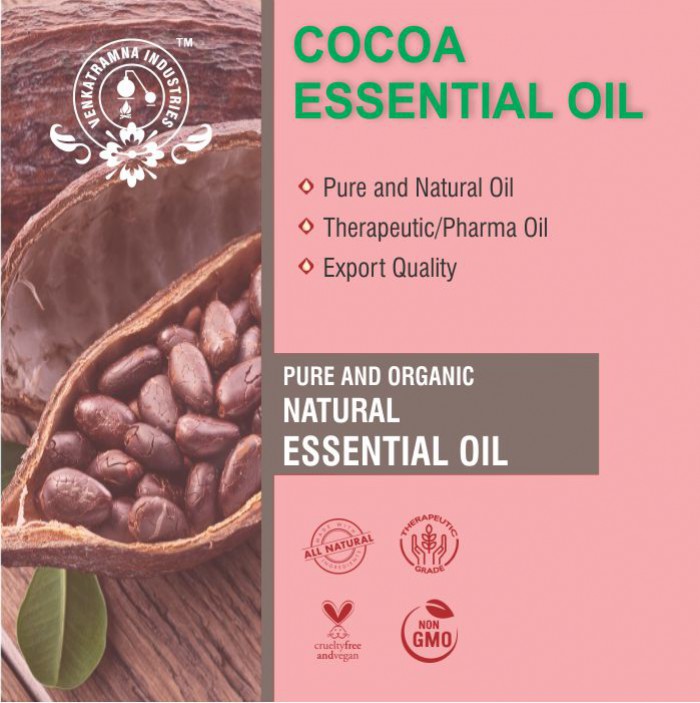Botanical Name: Theobroma cacao Common name: Cocoa Tree Plant Read More
|
Botanical Name: |
Theobroma cacao |
|
Common name: |
Cocoa Tree |
|
Plant family: |
Malvaceae |
|
Genus: |
Theobroma |
|
Appearance/Color: |
A very thick
liquid which gets dark brown color after processing |
|
Odor: |
Sensuous aroma, also
smells warm, spicy and mildly sweet |
|
Blends With: |
Bergamot,
Vanilla, Coffee and Orange |
|
Origin: |
France |
|
Source: |
Seeds |
|
Method of
Extraction: |
Solvent Extraction |
Theobroma cacao, also
called the cacao tree and the cocoa tree, is a small (4–8 m (13–26
ft) tall) evergreen tree in the family Malvaceae, native to the deep tropical
regions of Mesoamerica. Its seeds, cocoa beans, are used to make chocolate
liquor, cocoa solids, cocoa butter and chocolate.
The
cocoa bean with its products (cocoa liquor, cocoa powder, and dark chocolate)
is very rich in phenolic acids (10%–12%, dry weight). Being one of the richest
sources of flavanols (around 60% of total phenolics in raw coca beans)—a
subclass of flavonoids—cocoa is considered as one of the most significant
contributors of total dietary flavonoid intake in the human diet. Cocoa
flavonols are mostly flavanol monomers (epicatechin and catechin) and
procyanidin oligomers (dimer to decamer), which have been reported as
significant antioxidants. Catechins are flavan-3-ols and procyanidins are
oligomeric flavonoids consisting of 2–10 covalently linked epicatechin and
catechin moieties. More commonly, catechin and procyanidins groups in cocoa are
together considered as total “cocoa flavonoids”. The flavonoid content per
weight of cocoa has been reported as being higher than red wine, green tea, and
black tea. Moreover, total amount of flavonoids in dark chocolate is higher
than that of milk chocolate.
COMMON USAGE
·
Used as a base for suppositories and ointments,
·
Manufacture of creams, Food beverages (as
flavouring substitute)
·
Manufacture toilet soaps
Ingredients:
|
S. No |
Key Constituents |
Strength (%) |
|
1 |
Vanillin |
<1.9 |
|
2 |
Alcohol |
<2 |
|
3 |
Propylene Glycol |
<50 |
Other Ingredients: Contains of glycerides of stearic acid (34%), oleic acid (37%), Palmitic acid (25%), and small quantity of arachidic acid and linoleic acids. The non-greasiness of product is due to its glycerides structure.
TOXICOLOGICAL
INFORMATION
Organ-specific effects: no data available
Systemic effects
·
Acute toxicity: No data available.
·
Skin corrosion/irritation: May be
irritating to skin.
·
Serious eye damage/irritation: May be
irritating to eyes. Prompt rinsing and removal of the substance will avoid
damage.
·
Respiratory sensitization: Breathing high
concentrations of vapor may cause anesthetic effects.
·
Germ cell mutagenicity: Not specified
·
Carcinogenicity:
IARH: No component of this product present at levels
greater than or equal to 0.1% is identified as probable, possible or confirmed
human carcinogen by IARC.
ACGIH: No component of this product present at levels
greater than or equal to 0.1% is identified as probable, possible or confirmed
human carcinogen by IARC.
NTP: No component of this product present at levels
greater than or equal to 0.1% is identified as probable, possible or confirmed
human carcinogen by IARC.
OSHA: No component of this product present at levels
greater than or equal to 0.1% is identified as probable, possible or confirmed
human carcinogen by IARC.
·
Reproductive toxicity: Not specified
·
STOT-single exposure: Not specified
·
STOT-related exposure: Not specified
·
Aspiration hazard: Not specified
ECOLOGICAL
INFORMATION
·
Aquatic Toxicity: toxic to aquatic life with long lasting
effects
·
Bioaccumulation: unlikely
·
Mobility in soil: No data available
·
Persistence and degradability: biodegradation
expected
·
PBT and vPvB assessment: No data available
·
Other adverse effects: Do not allow it to enter
into water systems and marine environment.










